Summary Overview
Data Cables Market Latest Industry Overview
The global data cables market is undergoing significant changes, driven by the rising demand for high-speed data transmission, advancements in technology, and expanding applications across industries such as telecommunications, data centers, and automotive. This dynamic market is influenced by the proliferation of data centers, the rise of cloud computing, and the expansion of telecommunication networks. Our report provides a comprehensive analysis of emerging procurement trends, highlighting opportunities for cost savings through strategic sourcing and innovative manufacturing practices. We also address future challenges in the supply chain and emphasize the importance of digital procurement tools in accurately forecasting market dynamics to help clients navigate this evolving landscape. Strategic sourcing and procurement management play a crucial role in streamlining the procurement process for development. As competition intensifies, companies are leveraging market intelligence solutions and procurement analytics to optimize their supply chain management systems.
The outlook for the data cables market is promising, with several key trends and projections indicating substantial growth through 2032:
-
Market Size: The global data cables market is projected to grow from USD 87.26 billion in 2023 to USD 140 billion by 2032, reflecting a compound annual growth rate (CAGR) of 8.8% from 2024 to 2028.
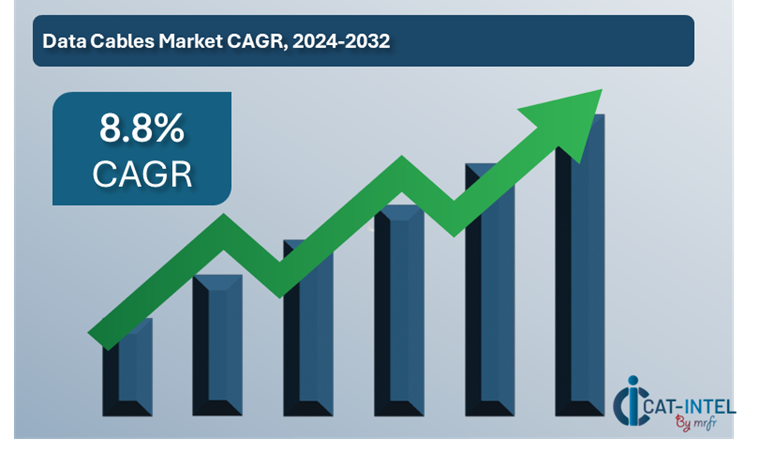
Sector Contributions
-
Telecommunications: The expansion of 5G networks and increasing internet penetration are driving the demand for high-performance data cables to support enhanced connectivity. -
Data Centers: The surge in cloud computing and data storage requirements necessitates robust cabling infrastructure, contributing significantly to market growth. -
Automotive Industry: The integration of advanced driver-assistance systems (ADAS) and in-vehicle infotainment systems is propelling the need for specialized automotive data cables.
Technological Transformation and Innovations
Advancements in cable materials and manufacturing technologies are enhancing data transmission speeds and reducing signal loss. The development of high-speed and high-bandwidth data cables, as well as next-generation cables for AI integration, are notable trends in the market.
Funding Initiatives
Significant investments are being made in expanding and upgrading cable infrastructure to meet the growing demand for data transmission. For example, companies in Southeast Asia are investing in new undersea fiber-optic cables to boost the region's data center industry.
Regional Insights
-
Asia-Pacific: This region is expected to witness substantial growth due to rapid industrialization, urbanization, and the expansion of telecommunication networks. -
North America: The presence of major technology companies and continuous advancements in networking technologies contribute to steady market growth.
Key Trends and Sustainability Outlook
-
Sustainability Initiatives: The focus on sustainable manufacturing practices is gaining momentum, with companies investing in eco-friendly materials and energy-efficient production processes. -
Technological Advancements: The development of smart data cables with self-diagnostics and modular, scalable cable solutions are enhancing market dynamics. -
Infrastructure Expansion: Ongoing investments in infrastructure, such as undersea cables, are expanding global connectivity and supporting the increasing demand for data transmission.
Growth Drivers
-
Digital Transformation: The global shift towards digitalization across industries is increasing the demand for reliable and efficient data cables. -
Emerging Technologies: The adoption of technologies like the Internet of Things (IoT), artificial intelligence (AI), and machine learning is driving the need for high-speed data transmission solutions. -
Government Initiatives: Increased government investments in the transmission and distribution of electricity and data are propelling market growth.
Overview of Market Intelligence Services for the Data Cables Market
Recent analysis indicate that the data cables market is experiencing fluctuations in pricing due to variable raw material costs and increased demand. To navigate these challenges, market reports provide detailed cost forecasts and procurement strategies that help stakeholders optimize their purchasing decisions. By leveraging insights from these reports, producers and buyers can effectively manage cost volatility while ensuring access to high-quality data cables. Implementing strategic sourcing practices will enable stakeholders to mitigate risks and enhance their competitive advantage in the marketplace.
Procurement Intelligence for Data Cables Market: Category Management and Strategic Sourcing
"To stay ahead in the data cables market, companies are optimizing procurement strategies, leveraging spend analysis solutions for vendor spend analysis, and enhancing supply chain efficiency through supply market intelligence. Procurement category management and strategic sourcing are becoming vital in achieving cost-effective procurement and ensuring the timely availability of high-quality data cables for production and distribution."
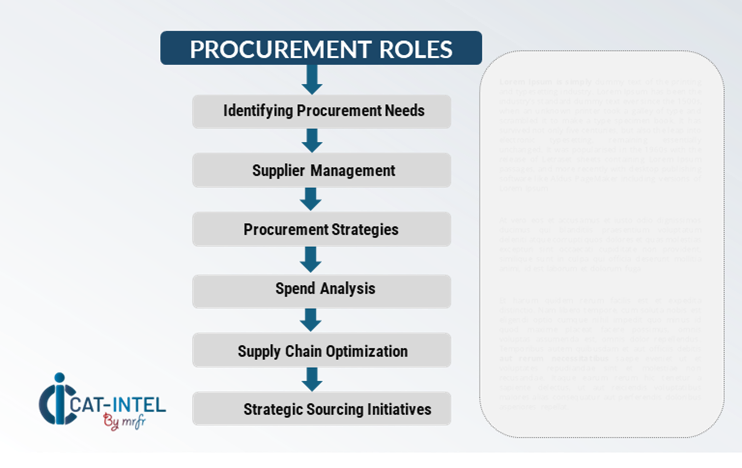
Pricing Outlook for Data Cables Market: Spend AnalysisThe data cables market is navigating a dynamic pricing landscape, influenced by fluctuating raw material costs, technological advancements, and increasing demand from industries such as telecommunications, data centers, and automotive. This complex environment reflects the ongoing evolution of production techniques and consumer requirements.
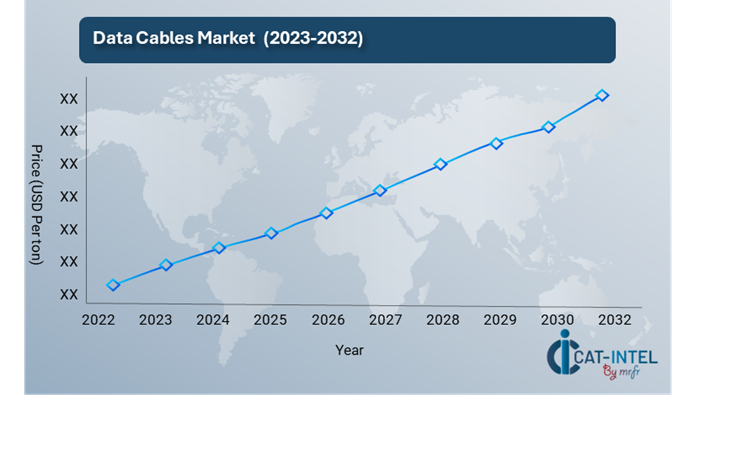
A line chart illustrating the pricing outlook for the data cables industry from 2024 to 2032. The chart shows the projected price trends, with prices exhibiting moderate growth over the years due to steady demand and technological advancements.
Our advanced analysis indicates a steady growth trajectory in data cable prices driven by several key factors, including:
-
Rising Raw Material Costs: The increasing prices of copper, aluminum, and polymers, essential for cable production, are contributing to higher production costs. -
Surge in Demand: The growing adoption of high-speed internet, 5G networks, and cloud computing is driving demand for advanced data cables globally. -
Export Opportunities: Expanding markets in Asia-Pacific, particularly in countries like India and China, are creating competitive pricing pressures, adding to price variability. -
Technological Advancements: The integration of innovative technologies, such as fiber-optic and AI-enabled cables, is influencing product pricing dynamics.
Cost Breakdown for the Data Cables Market: Cost-Saving Opportunities
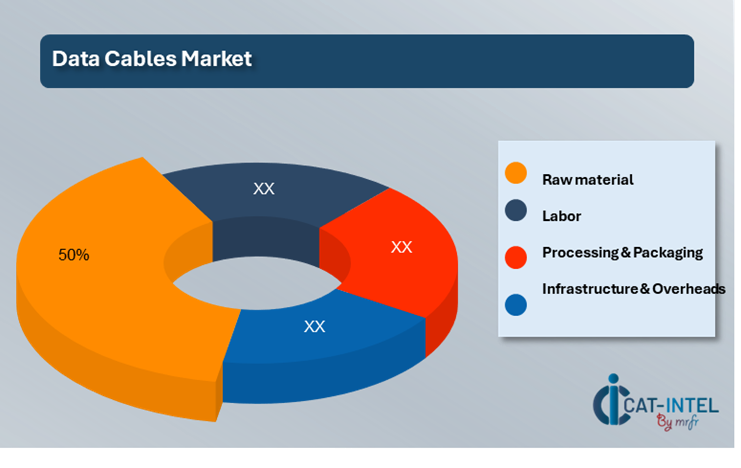
- Raw Materials (50%)
-
Description: Represents the bulk cost of primary materials such as copper, aluminum, polymers, and fiber optics, which are essential for data cable manufacturing. -
Trends: Prices for raw materials are rising due to increased global demand, particularly for copper and fiber optics, driven by expanding 5G networks and data center developments. As of 2024, the global focus on sustainable sourcing has added cost pressures, with additional premiums on eco-friendly materials.
- Labor (XX%)
- Processing & Packaging (XX%)
- Infrastructure & Overheads (XX%)
Cost saving opportunity: Negotiation Lever and Purchasing Negotiation Strategies
In the data cables market, cost savings can be achieved through collaborative sourcing for bulk discounts, supplier consolidation for better pricing, and lean manufacturing to reduce operational expenses. Leveraging AI-driven procurement tools optimizes purchasing decisions, while energy-efficient operations and freight optimization minimize utility and transportation costs. Flexible contracts and vertical integration further enhance cost control, ensuring profitability and competitiveness.

Supply and Demand Overview of the Data Cables Market: Demand-Supply Dynamics and Buyer Intelligence for Effective Supplier Relationship Management (SRM)
The data cables market is witnessing robust growth fuelled by the expansion of digital infrastructure, increasing demand for high-speed connectivity, and advancements in technology. The demand is particularly strong in sectors such as telecommunications, data centers, and industrial automation, driven by the global shift towards digitization and smart technologies.
Demand Factors:
-
Digital Transformation: The rapid adoption of cloud computing, IoT, and 5G networks drives demand for high-performance data cables. -
Data Center Expansion: The proliferation of data centers worldwide increases the need for reliable and scalable cabling solutions. -
Industrial Automation: Growth in automated manufacturing and smart factories necessitates advanced cabling for seamless connectivity. -
Consumer Electronics Growth: Rising sales of smart devices and wearables further boost demand for data cables.
Supply Factors:
-
Raw Material Availability: Stable supply of key materials like copper, aluminum, and fiber optics ensures consistent production of data cables. -
Technological Innovations: Advancements in cable manufacturing, such as high-speed fiber optic cables, enhance supply capabilities. -
Sustainability Focus: Increasing emphasis on recyclable materials and eco-friendly production processes aligns with global sustainability goals. -
Global Competition: Competitive pricing and production strategies among suppliers maintain a steady supply to meet growing demand.
Regional Demand-Supply Outlook: Data Cables Market
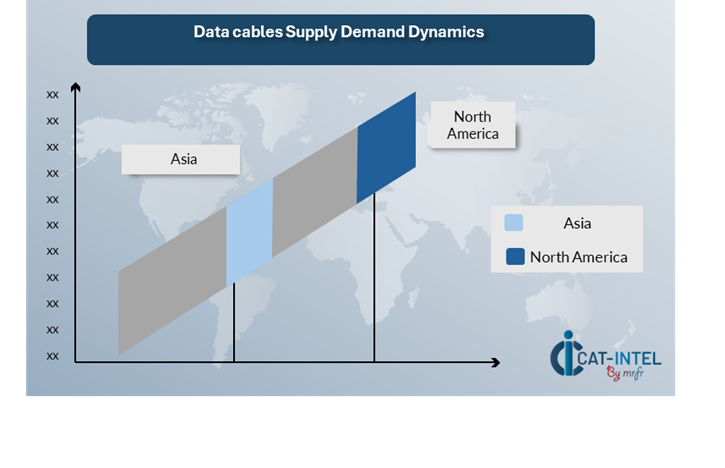
The image highlights the growing demand for data cables in both North America and Asia, with rising investment in digital infrastructure and heightened competition.
North America: A Key Player in the Data Cables MarketNorth America, led by the U.S., plays a central role in the data cables market, characterized by:
-
Advanced Digital Infrastructure: The U.S. drives demand with widespread deployment of fiber optic and high-speed cables to support 5G networks and broadband expansion. -
Rising Data Center Investments: The proliferation of hyperscale data centers necessitates extensive cabling solutions to handle increasing data traffic efficiently. -
Innovation in Cable Technology: Development of cutting-edge technologies, such as low-latency fiber optics, positions North American producers as market leaders. -
Sustainability Initiatives: Emphasis on recyclable materials and energy-efficient production aligns with evolving environmental regulations and consumer preferences. -
Consumer and Business Trends: Growing reliance on IoT, smart homes, and enterprise networks continues to fuel demand for robust and scalable data cable solutions.
North America remains a key hub for Data cables market and its growth
Supplier Landscape: Supplier Negotiations and Strategies
The data cables market features a robust supplier landscape comprising global and regional players that provide essential materials, technologies, and services for cable manufacturing, installation, and distribution. Key suppliers offer raw materials like copper, optical fiber, polymer insulation, and advanced cabling technologies, which are critical to ensuring high-quality and efficient cable production.
Currently, the supplier landscape is shaped by strategic partnerships between manufacturers and raw material suppliers, facilitating cost optimization and enhanced product quality. These collaborations are vital in addressing the growing demand for data cables in industries like telecommunications, data centers, and smart infrastructure. Suppliers of polymer insulation and advanced optical fibers play a pivotal role in meeting performance standards, particularly in high-speed and long-distance communication networks.
Some of the key raw material suppliers in the data cables market include:
- Corning Incorporated
- Prysmian Group
- Furukawa Electric Co., Ltd.
- Nexans S.A.
- Sumitomo Electric Industries, Ltd.
- Belden Inc.
- Hengtong Group
- Southwire Company, LLC
- CommScope Holding Company, Inc.
- General Cable Corporation
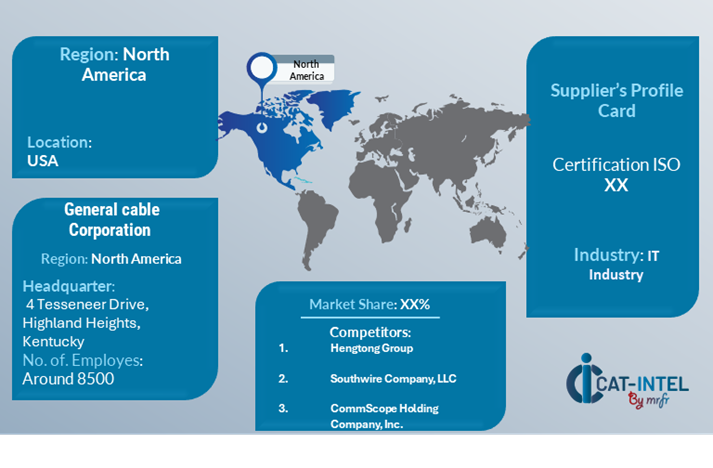
Key Development: Procurement Category significant development
Category |
Key Development |
Impact |
Raw Materials |
Increased demand for high-quality copper, optical fibers, and polymers. |
Rising material costs, supply chain pressures, and the need for strategic sourcing. |
Sustainable Sourcing |
Growing adoption of eco-friendly materials and production methods (e.g., recycled copper). |
Improved environmental footprint, lower costs in the long run, and greater appeal to eco-conscious customers. |
Technological Innovation |
Advances in cable technology, such as 5G-ready cables and fiber optic innovations. |
Enhanced product performance, increased demand, and the need for continuous supplier innovation. |
Supply Chain Efficiency |
Integration of digital procurement tools and automation. |
Improved procurement process efficiency, cost savings, and enhanced supply chain visibility. |
Vendor Management |
Strategic partnerships with key suppliers (e.g., optical fiber manufacturers). |
Strengthened supplier relationships, improved bargaining power, and optimized supply security. |
Procurement Attribute/Metric |
Details |
Market Sizing |
The global data cables market is projected to grow from USD 87.26 billion in 2023 to USD 140 billion by 2032, with a CAGR of 8.8% during the forecast period. |
Adoption of Data Cables in Industry |
Increasing demand for high-speed data transfer, expansion of 5G networks, and growing IoT devices contribute to higher adoption of data cables, particularly fiber optic and high-performance copper cables. |
Top Strategies for 2024 |
Focus on product innovation (e.g., 5G-ready cables, high-speed fiber optics), strategic global sourcing, and cost optimization in manufacturing processes. |
Automation in Data Cable Manufacturing |
Over 30% of data cable manufacturers are adopting automated production lines, including robotic systems for cable testing and cutting, to reduce production costs and improve precision. |
Procurement Challenges |
Key challenges include volatile copper and fiber optic prices, supply chain disruptions, and managing quality consistency in bulk orders. |
Key Suppliers |
Leading players include Nexans, Prysmian Group, Southwire Company, Belden, and LS Cable & System, focusing on innovation in high-performance cables for telecommunications, data centers, and industrial applications. |
Key Regions Covered |
Major markets include North America, Europe, and Asia-Pacific, with significant demand from the U.S., China, and Germany. |
Market Drivers and Trends |
Growth driven by increasing demand for high-speed data transfer, expansion of broadband and 5G networks, and the rising need for IoT solutions. The market is also driven by technological advancements in fiber optic cables. |








